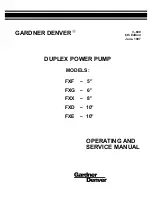
17
6.4.Periodic Maintenance
MOUNTLY
Measure the temperature of the bushings by a thermometer not by your hand. The
working of the bushings in high temperature (over 60°C) may be the result of
outwearing of the teflon. Dismantle and change the bushings.
The impermeability materials as elastromers (seals) may cause of the high
temperature. To correct the situation, oil the impermeability materials.
3 MONTHS
TIME
Control the bushings against outwear. If there has not been unknown particles or has’nt
been accessing any dust from seal, there won’t be a problem. If there is a problem as
being outwear or damage, changing will be a good solution. Also the bushings are
changed for the beter performance.
6 MONTHS
TIME
Control the gasket or the seal and change if necessary. Use the suggested class. Be
sure the gasket/seal is in the proper place.
Take the records of the vibration values in the casing. Compare the values (previous
and actual) due to a possible malfunction pump part.
Control the shaft due to the scratcs. The scratcs speed up the abbrasion of the gasket.
Check the alignment of the pump and the motor. Calibrate the system if necessary. If
the alignment problem repeats time and time again, control the whole piping system.
Control whether there is a flexion in the pipes after untighten the bolts on the inlet and
outlet flanges. By this way, determine the stress on the pump casing. Check all the
pipes whether they are supporting effective weight support. Fix properly if necessary.
ANNUALLY
Detach the back cover. Check the pump well against abrasion and order new spare
part if necessary. Control the idler and the rotor gaps. When the gaps become as three
times more than the original or a noticeable pressure loss for the same motor speed,
change the idler and the rotor.
Clean the sludges. Measure the total dynamic pressure and flow rate. Record the
numbers and compare them with the accurate ones. This is important when the liquid
makes sludges up in the casing.
Check the by-pass unit coupled to the casing. Check the by-pass vane to set for
assisting the by-pass unit especially with the stopping of the flow when the pump is still
operating.
NOTE: The schedule upwards was prepared in the assumption of the pump has been checked regularly
and it was noticed that this kind of a schedule is appropriate to the operating. When determining the
maintenance periods, excessive or off-beat procedures or conditions must be considered.
Table 5. Periodic Maintenance Plan
7.TROUBLESHOOTING
The possible problems when operating a pump;
A. The pump wears quickly
B. The pump has jammed
C. The motor is overloaded
D. The pump is making a noise
E. The flow rate is too low
F. The pump loses liquid after self-priming
G. The pump cannot self-prime
H. Lack of co-ordination between pressure and flow rate
Summary of Contents for ER 1134Y
Page 17: ...15 6 2 Disassembly Figure 17 Pump Disassembly ...
Page 24: ......






































